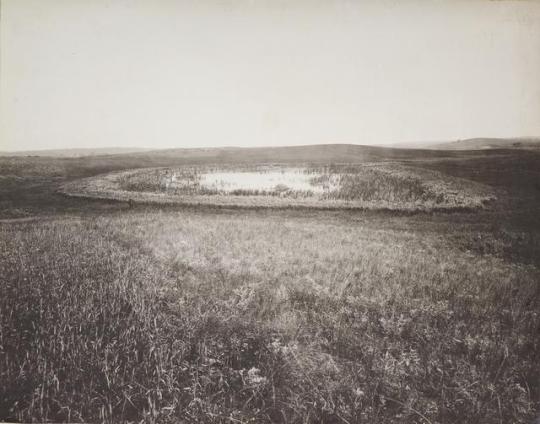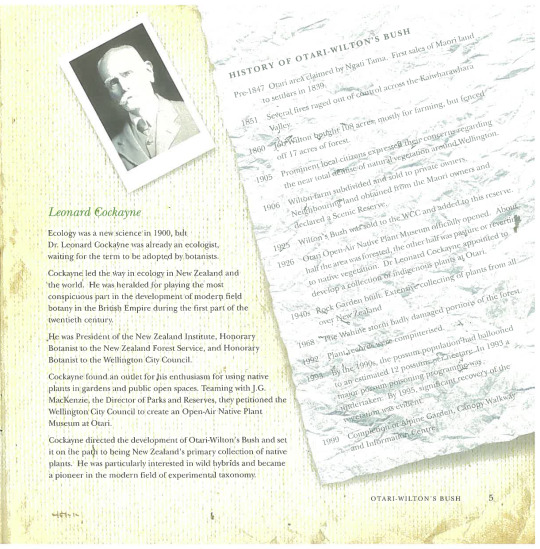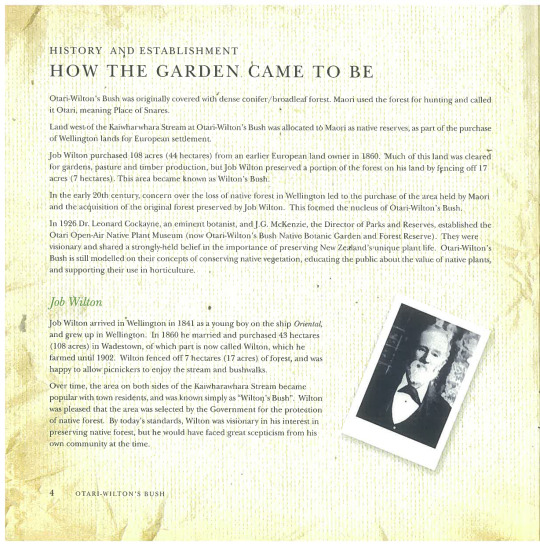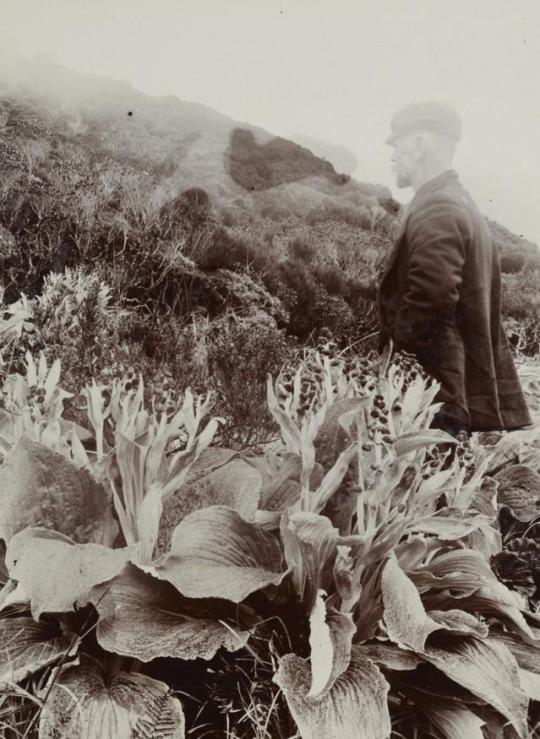#Dr Leonard Cockayne
Text

Samuel Page - Dr Cockayne, botanist, inspecting native florae. From the album: [1907 Sub-Antarctic Expedition]; circa 1908; North, W.
#Samuel Page#Auckland Islands#Dr Leonard Cockayne#1907 Sub-Antarctic Islands Scientific Expedition#expedition#gelatin silver print#plant
122 notes
·
View notes
Photo

Zonal distribution, prairie swale, circa 1900-1930, by Dr Leonard Cockayne F.R.S. Te Papa (O.041700)
42 notes
·
View notes
Text
Ōtari-Wilton’s Bush Notes
Ōtari – meaning ‘place of snares’ – was originally covered with dense podocarp broadleaf forest and was a rich hunting ground for Māori. With the arrival of Europeans, trees were felled and burnt to make way for farms, but among the early settlers were those with a vision to preserve this beautiful piece of bush, such as early landowner Job Wilton who preserved seven hectares of the original forest. This became known as Wilton’s Bush.
The landscape once thick forest of rimu and rata towering over a canopy of tawa, hinau and kohekohe. Forest clearance in Wellington peaked during early European colonisation. Land was cleared for farming and trees taken to build. One of the early landowners, Job Wilton, preserved seven hectares of the original forest and fenced it off . This is now known as Wilton’s Bush. In 1906 the forest was gazetted as scenic reserve. In 1926 the Ōtari Open Air Native Plant Museum was established by Dr Leonard Cockayne and J G McKenzie (Director of Parks). Their vision was to conserve the native forest, cultivate plants from all over New Zealand, teach people about native plants and advocate their use in horticulture. This remains the blueprint for Ōtari-Wilton’s Bush today.
More than half of all remaining original native forest in Wellington lies within Otari's boundaries
100 hectares of ancient and regenerating native forest.
Can join the trust and volunteer to help with seeding, propagation, research, restoration etc.
The forest has been a recreation area for Wellingtonians since the 1860’s. Most of Otari-Wilton’s Bush is classified as Scenic Reserve
Otari-Wilton’s Bush nestles in the deep valley formed by the Kaiwharawhara Stream (also known as Te Mahanga Stream) flowing northeast towards Ngaio Gorge. The trust successfully restored the unique ecosystem of the main stream flowing through Ōtari.
Large podocarps such as rimu, totara, miro and matai can be readily seen. Kohekohe, rewarewa, tawa and mahoe trees dominate the upper slopes, and in valley areas tall pukateas are found. About 150 species of flowering plants, podocarps and ferns can be found growing naturally in the forest.
In March 2007, a ‘Bioblitz’ was conducted with the goal of counting as many species as possible during a 24 hour period. The final count was 1345 species.
The reserves through which the stream flows openly (including Otari-Wilton’s Bush) mean that pockets of biodiversity occur which can provide a pool of organisms that can recolonise the stream following a flood, drought or spillage event. The stream is how the reserve thrives.
Traditional occupation rights over the Otari area are claimed by Te Atiawa/Taranaki Whanui which includes Ngati Tama. Te Kaeaea, a Ngati Tama chieftain, lived at Kaiwharawhara Pa at the mouth of the Kaiwharawhara Stream. (historical outline starts pg. 54)
Resources:
https://owbt.nz/about.html
https://wellington.govt.nz/~/media/maps/files/otari-forest-tracks.pdf
https://wellingtongardens.nz/assets/Otari-WiltonsBushBrochure.pdf
https://wellington.govt.nz/~/media/your-council/plans-policies-and-bylaws/plans-and-policies/a-to-z/otari/files/otarimgmtplan.pdf
https://bts.nzpcn.org.nz/site/assets/files/23050/wbs52-03-09-lewington.pdf
Scans below from 'Otari Wilton's Bush'
contributers, Anita Benbrook ... [et al.]. Wellington Botanic Garden / contributers, Leanne Killalea, Caren Sage. 2002


0 notes
Text
History about the bush
Otari-Wilton's Bush was originally covered with podocarp broadleaf forest. The name “Otari” is Māori for “Place of Snares”. The forest was a good place for bird hunting. When the region was colonized by Europeans, trees were removed for timber, and to create farmland.
The first part of the reserve to be protected was a 7 hectare area of original forest that was fenced off from stock in 1860 by a far-sighted local farmer, Job Wilton. This became known as Wilton’s Bush, in 1906 the forest was gazetted as scenic reserve. Many parts of the current Otari-Wilton's Bush reserve have been designated as reserve by the New Zealand government and Wellington City Council. This includes most of the remnants of the mature podocarpaceae forest that once cloaked all of Wellington and the surrounding hills.
The forest area holds native trees that are hundreds of years old, like matai Prumnopitys taxifolia and rimu Dacrydium cupressinum, as well as tawa Beilschmiedia tawa, rewarewa Knightia excelsa and kohekohe Dysoxylum spectabile.
The plant collections that now form the native botanic gardens, were the brainchild of eminent botanist Dr Leonard Cockayne, who started developing this collections in 1926.
link https://en.wikipedia.org/wiki/Otari-Wilton%27s_Bush
0 notes
Photo

Samuel Page, Dr Cockayne, botanist, inspecting native florae, 1907. From the album: [1907 Sub-Antarctic Expedition]; circa 1908; compiled by W. B. North. Te Papa (O.007044)
Dr Leonard Cockayne, (on not visiting Antipodes Island) in 1907... “The Subantarctic Expedition did not visit this small and isolated island. I can only, then, supply an account drawn from my former paper, but in imagination dressing the meadows in their summer garb.” — p. 227, ‘The Ecological Botany of the Subantarctic Islands’, The subantarctic islands of New Zealand. Reports on the geo-physics, geology, zoology and botany of the islands lying to the south of New Zealand, based mainly on observations and collections made during an expedition in the government steamer “Hinemoa” (Captain J. Bollons) in November, 1907. Edited by Chas. Chilton. Philosophical Institute of Canterbury, Christchurch, N.Z., 1909
Cockayne’s 1903 paper, ‘A Botanical Excursion during Midwinter to the Southern Islands of New Zealand’ can be viewed → here
347 notes
·
View notes
Text
Otari-Wilton’s Bush
Otari-Wilton’s Bush is the only botanic garden in New Zealand dedicated solely to native plants. This unique plant sanctuary and forest reserve consists of 100 hectares of native forest and five hectares of plant collections. Otari-Wilton’s Bush was originally covered with dense podocarp broadleaf forest. Maori used the forest for hunting and the name Otari means ‘Place of Snares’. Following European colonisation, some of the large trees were removed for timber and others were burnt off for farmland. One of the early landowners, Job Wilton, preserved seven hectares (17 acres) of the original forest and fenced it off. This became known as Wilton’s Bush. In 1906 the forest was gazetted as scenic reserve. In 1926 the Otari Open Air Native Plant Museum was established by Dr Leonard Cockayne and JG McKenzie. Their vision to conserve the native forest, cultivate plants from all over New Zealand, teach people about native plants and advocate their use in horticulture remains the blueprint for Otari-Wilton’s Bush today.
link https://wellington.govt.nz/-/media/maps/files/otari-forest-tracks.pdf
0 notes